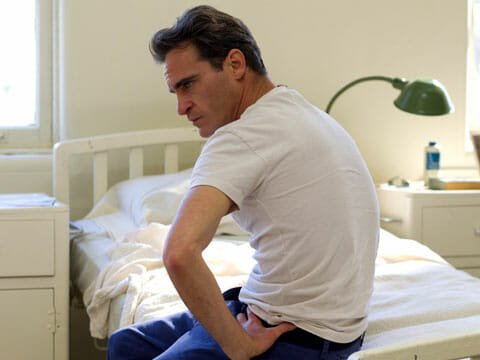
“Excuse me … excuse me … excuse me,” the voice insistently repeats. It is a thin voice, not imbued with the same presence as the one it interrupts. Prior to this moment in Paul Thomas Anderson’s The Master, Freddie Quell (Joaquin Phoenix) has drifted in the current of the charm and charisma of Lancaster Dodd (Philip Seymour Hoffman). But suddenly some dweeb is outlining all the logistical holes in Dodd’s nouveau religion. Dodd and his followers react with disdain and, for a moment, so does the film’s audience. Here at last is a voice of reason, but right now we are not seeking reason. We are in a dream, and damn anyone who dares to wake us.
This scene from early in the movie signals one in a series of awakenings in Dodd and Freddie’s relationship. It sets in motion the story’s key tension: the desire to follow something amazing versus the sneaking suspicion that it’s all crap.
The Master studies its characters with such mystique, tragedy and humor that there’s not a moment that isn’t enthralling. Writer/director Anderson continues some of the stylistic tendencies from his last film, There Will Be Blood, but he also finds ways to constantly take risks and make bold choices that are thoroughly unpredictable.
Dodd and his religion, The Cause, are obviously inspired by L. Ron Hubbard and Scientology, and that link was the focal point of the film’s pre-release press coverage. The parallels between the two ideologies are inescapable, yet they’re not the point. Anderson never adopts the viewpoint of religion/cult as freak show. Even in a brilliant montage depicting a series of grueling exercises that Freddie can’t or won’t let enlighten him, the personal struggle is in the forefront. The bizarreness of the rituals is almost incidental.
Phoenix gives the performance of his career as a booze-soaked World War II veteran with mental and physical scars. Having gleaned little benefit from a psychiatric crash-course for returning soldiers with post-traumatic issues, he stumbles around one place until he must flee to another, obsessing over sex and making experimental hooch. He resembles a mad scientist as he creates his concoctions, mixing booze with whatever hazardous substances he can find—paint thinner, photo chemicals, rocket fuel—whatever’s handy.
The most amazing part of Phoenix’s portrayal stems from his ability to take full advantage of the humor within his character. He is a sad man, a desperate man, an angry man—but there’s no denying the absurd humor inherent in his person. After Freddie drunkenly stows away upon Dodd’s river cruise party, Dodd takes a liking to him and takes him on board. He soon subjects Freddie to a nearly hypnotic question-and-answer session. The manner in which Phoenix delivers even the simplest one-word answers is remarkable.
If Freddie represents the unhinged and out of control, Dodd exudes precision charm. Philip Seymour Hoffman is one of the best actors working today, and this is some of his finest work. His performance has an unmistakable magnetism that makes it easy to understand why people follow Dodd. The most interesting thing about him may be his draw toward Freddie, a man whose unpredictability could ruin the religious empire he’s trying to build. Perhaps establishing control over Freddie would be the ultimate achievement. The greatest comparison between the two characters comes in a brilliant jail-cell scene that explores their dueling demeanors in one continuous, static shot.
Anderson populates The Cause with a rich cast of characters, none more prominent than Dodd’s wife, played with no-nonsense by Amy Adams as the brains behind the operation. We see people who willfully and happily accept The Cause and let it enlighten their lives with windows into their past ones. Freddie, however, receives no enlightenment, just torment.
Freddie never verbally expresses his own belief in The Cause or his love for Dodd, but he acts out in angry violence whenever anyone else casts dispersions. He knows it’s bogus, but he doesn’t want to know. He shows the same denial toward his hometown quasi-girlfriend from during the war, whom he obsesses over yet refuses to visit. He wants to be with her, yet doing so would require that he face reality instead of his dream.
From a technical perspective, one might expect the extreme detail of The Master’s 70mm format to cancel out the film’s ethereal feel; instead, it only makes it stronger. The film creates a world possessed of a sort of heightened reality, where you can see the curve of every ripple a boat leaves in its wake. The film is so grandiose that it can afford to be quiet, confident that we’ll catch the details—and discover new ones with each viewing. Anyone with the opportunity should watch the film in its native format. (Sadly, this will not be possible for most moviegoers outside of a few select cities.)
Anderson has always been a visual virtuoso, and he uses the added detail to superb effect. Dodd first appears during a tracking shot of Freddie, seen in the distance as a tiny but exuberant figure on a cruise ship, small yet still the center of attention. Freddie has not yet met Dodd, but the boat is calling to him. That could be because Dodd knew Freddie in a past life, or it could be because Freddie is a desperate drunk looking for a place to hide. Freddie’s great tragedy is that the less appealing explanation gives him no answer, while the other gives him the wrong answer.
Director: Paul Thomas Anderson
Writer: Paul Thomas Anderson
Starring: Philip Seymour Hoffman, Joaquin Phoenix, Amy Adams, Jesse Plemons
Release Date: Sept. 14, 2012